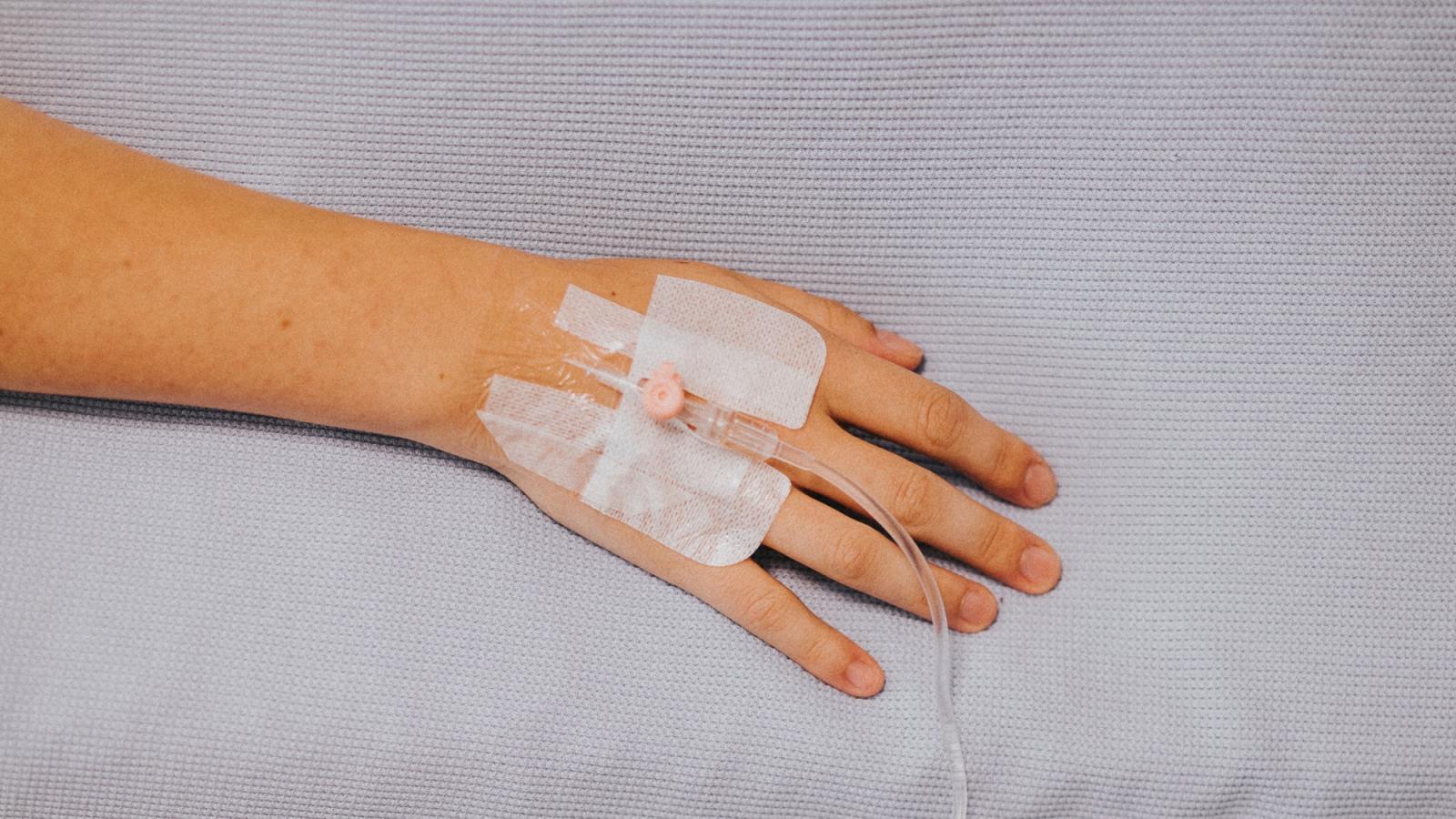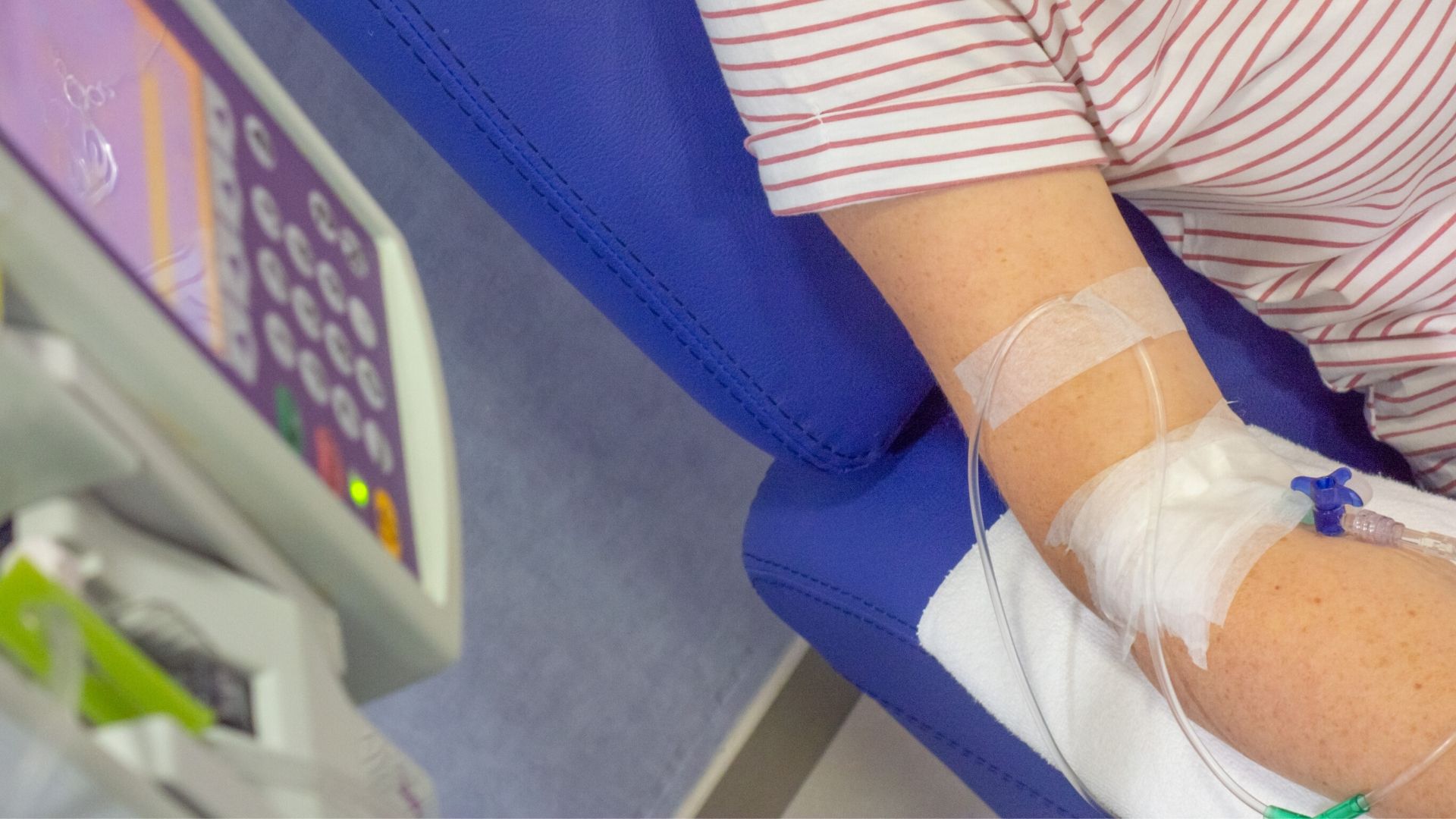Ways of injecting drugs – ports and lines

Cancer drugs can be given directly into a vein using the following devices:
- Cannula – a short, thin tube is put into a vein in your arm or the back of your hand.
- Central line – a thin, flexible tube is put in through the skin of your chest or neck and into a vein in your chest.
- PICC line (peripherally inserted central catheter) – a thin, flexible tube is put into a vein in your arm and then put in (threaded through) to a vein in your chest.
- Implantable port (sometimes called a portacath) – a thin, soft, plastic tube is put into a vein. It has an opening (port) under the skin on your chest.
Cannula
The cannula is put into a vein in the back of your hand or arm and secured with a clear dressing. It is normally removed after your treatment. If you need to stay in hospital, it may be left in place for a few days.
The drugs can be given through the cannula as an injection or injected into a bag to dilute them. Your treatment is often given through a pump so that your nurse can control how much of the drug you get over a set period of time.
You may feel some discomfort, pain, swelling, burning or a change in sensation around the cannula area while the drug is being given. This may be due to a small leakage of the drug into your tissues. This doesn’t happen often, but if it does, let your nurse or doctor know straight away.
Central line
A central line is a long, thin, hollow tube that is inserted into a vein in your chest. It is sometimes called a skin-tunnelled central venous catheter. A central line may also be called by its brand name. For example, Hickman® or Groshong®.
Your central line will be put in at the hospital by a doctor. You will usually be given a local anaesthetic, but sometimes a general anaesthetic is used. Before the procedure, your neck will be checked for a suitable vein using a small ultrasound machine.
Your doctor will make a small cut in the skin near your collarbone and gently put (thread) the tip of the line into a large vein just above your heart. The other end of the line is put in (tunnelled) under your skin to reach the exit site. This is where it comes out of your body. You will be able to see a thin tube come out of your chest. It may divide into 2 or 3 tubes so you can have different treatments at the same time. You will have a chest X-ray afterwards to make sure the line is in the right place.
Around the central line, you will feel a small ‘cuff’ just under the skin. The tissue under your skin will grow around this cuff in about three weeks and hold the line safely in place. Until this happens, you will have a stitch holding the line in place.
You will be taught how to care for this line at home, if necessary.
PICC line
PICC stands for peripherally inserted central catheter. This line is a long, thin, hollow tube that your doctor puts into a vein near the bend in your elbow. You will be given a local anaesthetic to numb the area before the line is put in.
The doctor gently threads the line along the vein until the tip sits in a large vein in your chest. You will see one or two thin tubes come out from your arm. Once it is in place, the PICC line is taped firmly to your arm to prevent it being pulled out of the vein. It can stay in place throughout your treatment. It will be held in place by stitches, which will remain there while the line is in.
Implantable ports (portacaths)
An implantable port is a thin, soft plastic tube with a rubber disc (port) at the end. It can be put in under a general or local anaesthetic. The tube is inserted into a vein until its tip sits just above your heart and the port lies under the skin on your upper chest. You cannot see the port as it is underneath your skin, but you will be able to feel it like a small bump.
A special needle called a Huber needle is put into the port in the hospital to allow the drugs to be given through the port. Blood can also be taken from the vein through the port. The implantable port can be used for as long as is needed.
Caring for your line or implantable port
Before you go home, the nurses will show you how to care for your line or port. If you find this difficult, your nurse will arrange a nurse in your community to do it or they will show a relative or friend how to do it for you.
If you notice a split or leak in the line…
If the split occurs above the triangle (double and triple lumen lines), you will be unable to move the clamp above the split. If this happens, cover the damaged area with an IV3000 dressing first. Then close off the line above this area using a clean clothes peg, or by tying it off using string, wool, etc. Contact the hospital immediately for advice. Depending on the damage, it may be possible to repair the line.
If the line falls out or slips…
- Put a dressing over the area
- To stop any bleeding, put pressure where the line comes out (exit site) on your chest and also on the small incision site on your neck.
- Contact the hospital for advice.
An X-ray may be done to check that all the tubing is gone. If the line is pulled by accident, you may see the cuff of the line when you change the dressing. If this happens, you must contact the hospital.
If there is redness or soreness around the skin….
If you notice the exit site is red or has any inflammation or pus, take your temperature and contact the hospital.
If you start to shiver immediately or several hours after flushing the line, take your temperature and contact the hospital for advice. This shivering may be a sign of infection in the line.
Possible problems with your line or implantable port
Most people won’t have any serious problems with their line or port, but possible problems can include blockage and infection. Your nurse will tell you what to look out for. Contact the hospital for advice straight away if you have:
- Soreness, redness or darkening of the skin around the line or port
- Fluid leaking from the skin around the line or port
- Swelling of your arm, chest, neck or shoulder
- Pain in your chest, arm or neck
- A high temperature. Most hospitals say that a temperature above 38°C (100.4°F) is high, but some use a lower or higher temperature. The cancer doctors and nurses at your hospital will advise you.
You should also contact the hospital if you are feeling shivery or unwell after your line or port has been flushed.
- Keep the site clean and dry.
- Always wash your hands before handling the line
- Be careful when removing your clothes, so the line does not get caught.
- When showering or bathing, place a shower sleeve or clingfilm over the site. Your nurse will discuss this with you.
- Avoid swimming, as it may cause infection.
- Do not lift heavy objects with the arm containing your PICC line.
- Wear loose-fitting tops or shirts for easy access.
- Avoid sports like tennis, badminton or hurling, as they might dislodge the line.
- Do not pull or tug on the tubing.
- If you are worried that your site is showing signs of infection or clotting, contact the day unit immediately.
- If your line falls out, place a clean dressing over the site.
- If the wound bleeds, apply pressure with a clean dressing.
- If the line falls out at home, do not throw it away but bring it to the hospital.
Talk to your doctor or nurse about the different ways of getting intravenous chemotherapy. They will explain the different options to you. Remember the type of line you are given can depend on the chemotherapy drugs that are used, their doses and the length of time you are expected to be on treatment. A line might also be put in if your medical team feels that your veins will not tolerate the chemotherapy.
For more information
Phone
1800 200 700


